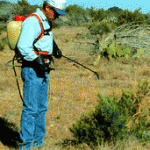 Cedar Leaf Spray Method
Cedar Leaf Spray Method
Works Best:
On blueberry or redberry cedars less than 3 feet tall.
When to Apply:
Late spring through summer, when cedar is actively growing.
1. Prepare Equipment
Small pump-up garden sprayers, backpack sprayers, cattle sprayers, or sprayers mounted on 4-wheel-drive all-terrain vehicle, (ATVs) work well. Garden sprayers, are best for treating a few plants, and backpack sprayers are usually more efficient for larger acreages or higher cedar densities. ATV sprayers become more efficient on very large acreages or as the distance between plants increases. Make sure your spraygun has an adjustable cone nozzle (X6 to X8 orifice size) capable of delivering a coarse spray (large droplets).
2. Mix Herbicide Spray
You can achieve 76 to 100 percent rootkill of small cedar by spraying with the herbicide Tordon 22K™. Prepare the spray mix as a 1% concentration of Tordon 22K™ in water (see following table). To ensure a thorough coating of the ceder leaves, add commercial surfactant or liquid dishwashing detergent to the spray mix. It may be helpful to add a dye, such as Hi-Light Blue Dye™, to mark plants that have been sprayed.
Recommended leaf spray for cedar.*
| Ingredient | Concentration in spray solution | Tank Size | ||
| 3 gal. | 14 gal. | 25 gal. | ||
| TordonK™ | 1% | 4 oz. | 18 oz. | 32 oz. |
| Surfactant or dishwasing detergent | 1/4% | 1 oz. | 5 oz. | 8 oz. |
| Hi-Light Blue Dye™ | 1/4-1/2% | 1-2 oz. | 5-9 oz. | 8-16 oz. |
*All spray solutions are mixed in water.
3. Spray the Cedar
Thoroughly wet all the leaves of each cedar plant to the point of runoff.
Keep these points in mind:
- The purchase of Tordon 22K™ requires a Pesticide Applicator License from the Texas Department of Agriculture. See your county Extension agent for license information.
- Follow herbicide label directions.
- Do not spray within 100 feet of known sinkholes or fractures that would allow herbicide to enter underground water aquifers.
- Do not spray if cedar foliage is wet.
- Do not spray immediately upwind of desirable trees, shrubs or susceptible crops.
- Cost of treatment increases rapidly as density and size of cedar increases.
- Large, mature blueberry cedar may be nesting habitat for the endangered golded-cheeked warbler. If in doubt, contact the U.S. Fish & Wildlife Service before treating.
- Do not treat large numbers of cedars beneath the canopies or within three times the height or diameter of desirable trees such as oaks or pecans.